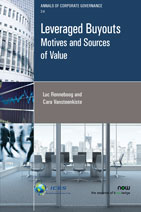Leveraged Buyouts: Motives and Sources of Value
Luc Renneboog, Tilburg University, The Netherlands and ECGI, Belgium, Luc.Renneboog@UvT.nl , Cara Vansteenkiste, Tilburg University, The Netherlands, c.vansteenkiste@tilburguniversity.edu>Abstract
This paper provides an exhaustive literature review of the motives for public-to-private LBO transactions. First, the paper develops the theoretical framework for the potential sources of value creation from going private: a distinction is made between the reduction in agency costs, stakeholder wealth transfers, tax benefits, transaction costs savings, takeover defense strategies, and corporate undervaluation. The paper then reviews and summarizes whether and how these theories have been empirically verified in the four different strands of literature in LBO research. These strands of literature are categorized by phase in the LBO transaction: Intent (of a buyout), Impact (of the LBO on the various stakeholders), Process (of restructuring after the leveraged buyout) and Duration (of retaining the private status). Then, the paper shows that in the first half of the 2000s, a public-to-private LBO wave re-emerged in the US, UK and Continental Europe, whose value vastly exceeded that of the 1980s US LBO wave. Finally, the paper provides suggestions for further research.
Leveraged Buyouts: Motives and Sources of Value
Leveraged Buyouts: Motives and Sources of Value analyzes the motives for taking public firms private and provides a structured and critical review of the empirical research in this area. The authors examine which types of firms go private and the determinants of takeover premiums in LBO transactions; investigate whether the post-transaction value creation, as well as the duration of the private status, can be explained by the aforementioned potential value drivers; answer the questions whether or not Public-to-Private (PTP) transactions lead to superior organizational forms compared to public firms, and whether going private is a shock therapy to restructure firms generating both strong short- and long-term returns; and document the trends and drivers of global LBO activity in the 1980s, 1990s, and the subsequent decades.
After a short introduction, Section 2 briefly discusses on the different types of leveraged buyouts and going-private transactions. Section 3 discusses the theoretical considerations underlying the sources of wealth gains from going private deals. Section 4 focuses on the four main strands of the literature – namely, on the Intent to do an LBO, on the Impact of the LBO measured by changes in the share price returns, on the LBO Process or on how the firm is restructured in the post-LBO stage, and on the Duration of being a private firm – and on the empirical evidence supporting the eight motives proposed by each strand of the literature. Section 5 explains the drivers behind the observed LBO waves that emerged over the past 35 years. Section 6 lines out a future research agenda.
